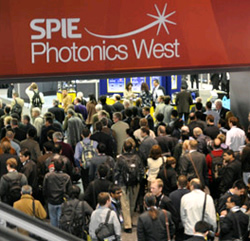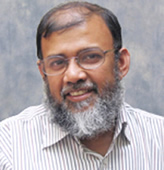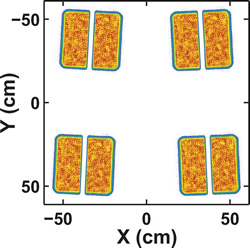Photons & Fusion
January 2011
Photons & Fusion is a monthly review of science and technology at the National Ignition Facility & Photon Science Directorate. For more information , submit a question.
NIF & PS Research Highlighted at Photonics West

More than 20 presentations, ranging from laser safety at NIF to advanced inertial fusion energy and gamma-ray sources, shined the spotlight on Lawrence Livermore National Laboratory's laser and photonics research at the SPIE Photonics West conference and exhibition held January 22-27 in San Francisco.
Many of the Lab presentations were part of a conference on "High-Power Lasers for Fusion Research" co-sponsored by the NIF & Photon Science Directorate. The conference was co-chaired by NIF's Abdul Awwal, Mike Dunne, and Chris Barty, along with colleagues from the University of Rochester, Osaka University in Japan, the French Atomic Energy Agency, and the Shanghai Institute of Optics and Fine Mechanics in China. NIF & PS also presented an exhibit featuring a 3-D "ride-along" animation of a NIF beamline in the exhibit hall of the Moscone Center.
Among the presentations were:
- A report by Mark A. Rhodes and colleagues on an experimental study of high-Z gas buffers for gas-filled inertial confinement fusion (ICF) engines. The researchers noted that ICF power plants, such as the Laboratory's Laser Inertial Fusion Energy (LIFE) concept, may employ a high-Z, target-chamber gas-fill to moderate the first-wall heat-pulse due to X-rays and energetic ions released during target detonation. A related presentation by Jave Kane reported the results of modeling a LIFE "minichamber" experiment to investigate cooling of strongly radiating xenon buffer gas protecting the LIFE chamber wall.
- A discussion of compact, efficient, low-cost diode power conditioning for laser inertial fusion energy (IFE) by Andy Bayramian and colleagues. A diode pulser has been designed to operate efficiently and provide a means to minimize cost and size for the estimated 4.4 million pulsers needed for an IFE power plant.
- A description by Karl Wilhelmsen of the NIF automatic alignment system, a large-scale parallel system that directs all 192 laser beams along the 300-meter optical path to a 50-micron focus at target chamber center. As NIF becomes a continuously operated system and more experiments are performed, Wilhelmsen said, performance monitoring is increasingly more important for maintenance and commissioning work.
- Reports by Abdul Awwal, John Heebner, and their colleagues on the image processing and control and performance of NIF's programmable beam spatial shaping system, a series of liquid-crystal-based spatial light modulators that introduces "blocker" obscurations in the laser beam that shadow isolated flaws on downstream optical elements that might otherwise be damaged by high-fluence laser illumination.
Fusion Energy Study Committee Holds 2nd Meeting
The second meeting of the National Academies' committee studying the Prospects for Inertial Confinement Fusion Energy Systems was held Jan. 29 and 30 in San Ramon, CA (see December 2010 Photons & Fusion Newsletter). ![]() The panel heard presentations on laser-driven inertial fusion energy and indirect-drive targets by Mike Dunne, Program Director for LLNL's Laser Inertial Fusion Energy (LIFE) concept, and LIFE team members Andy Bayramian, Jeff Latkowski and Tom Anklam. In addition, LLNL's John Perkins presented an overview of inertial fusion energy (IFE) target designs, and the Lab's Wayne Meier discussed chamber and power plant designs for IFE. Copies of the presentations can be found here.
The panel heard presentations on laser-driven inertial fusion energy and indirect-drive targets by Mike Dunne, Program Director for LLNL's Laser Inertial Fusion Energy (LIFE) concept, and LIFE team members Andy Bayramian, Jeff Latkowski and Tom Anklam. In addition, LLNL's John Perkins presented an overview of inertial fusion energy (IFE) target designs, and the Lab's Wayne Meier discussed chamber and power plant designs for IFE. Copies of the presentations can be found here.
Also presenting during the weekend's public sessions were representatives of Lawrence Berkeley, Los Alamos, and Sandia national laboratories, the Naval Research Laboratory, and General Atomics in San Diego. On Jan. 31, the committee made site visits to LLNL, to tour NIF and hear presentation from NIF Director Ed Moses, Chief Scientist John Lindl, and others, and to Lawrence Berkeley Laboratory.
Sponsored by the U.S. Department of Energy, the two-year study was commissioned to assess the prospects for generating power using inertial confinement fusion; identify scientific and engineering challenges, cost targets, and R&D objectives associated with developing an IFE demonstration plant; and advise DOE on its development of an R&D roadmap aimed at creating a conceptual design for an inertial fusion energy demonstration plant. The study committee will also assess the current performance of various fusion target technologies. Its next meeting will be held March 30 to April 1 in Albuquerque, NM.
Abdul Awwal Elected a Fellow of OSA
Abdul Awwal of NIF's Laser Systems Engineering and Operations division has been elected a Fellow of The Optical Society (OSA), an international society for optics and photonics scientists,  Abdul Awwalengineers, educators, and business leaders. The OSA Fellow designation is awarded to members of distinction who have made significant contributions to the advancement of optics. Awwal is being recognized for contributions in laser beam alignment, pattern recognition, and digital optical computing. Awwal will be officially recognized at the OSA Annual Meeting to be held October 16-20, 2011, in San Jose, California.
Abdul Awwalengineers, educators, and business leaders. The OSA Fellow designation is awarded to members of distinction who have made significant contributions to the advancement of optics. Awwal is being recognized for contributions in laser beam alignment, pattern recognition, and digital optical computing. Awwal will be officially recognized at the OSA Annual Meeting to be held October 16-20, 2011, in San Jose, California.
Awall is topical editor of Applied Optics in the Information Processing Area, a journal published by OSA. A Fellow of the International Society for Optical Engineering (SPIE), Awall is a recipient of two R&D 100 awards for his work on optics and alignment at LLNL and has served as a founding chair for 15 SPIE conferences. In addition, Awwal's work in convergence in optical and digital pattern recognition appeared in a feature issue of Applied Optics on April 1, 2010. The issue dedicated 11 papers to the topics, three in the area of optically inspired recognition, four on digital pattern recognition with an underlying theme of biologically inspired computing, and four on the joint optimization in the digital and optical domain, specifically in terms of computational imaging.
Phasing ARC Laser Beams with Different Dispersions
The short-pulse, petawatt-class Advanced Radiographic Capability (ARC) beamline at NIF consists of four of the 192 NIF beamlines (one quad), with each ARC aperture operating in a split-beam architecture. For the purpose of NIC diagnostics, each of the eight ARC beams will be pointed at different targets and staggered in time to provide an eight-frame backlit movie of the target capsule implosion.  Near-field intensity profile of the NIF-ARC quad. The individual apertures are rotated because of the spherical geometry of the NIF target chamber.Simultaneously firing the full ARC quad will give the highest peak intensities on target and enable many high-energy-density (HED) physics experiments at NIF.
Near-field intensity profile of the NIF-ARC quad. The individual apertures are rotated because of the spherical geometry of the NIF target chamber.Simultaneously firing the full ARC quad will give the highest peak intensities on target and enable many high-energy-density (HED) physics experiments at NIF.
To maximize the laser intensity on target, it is desirable that all eight ARC beams be phased with each other. This could present a challenge because in the ARC design, two laser beams with different dispersions share the same NIF aperture.
In an analysis published in the Jan. 31 issue of Applied Optics, however (Appl. Opt. 50, 554-561 (2011); doi:10.1364/AO.50.000554), NIF and Photon Science researchers reported that dispersion imbalance between the two halves of the ARC beamline will not be the limiting factor in phasing the ARC aperture. The authors noted that this result is somewhat surprising given the many electric-field oscillations that occur over the duration of the pulse lengths analyzed in the paper; in a 10-picosecond pulse, for example, the electric field will go through more than 35,000 oscillations and the phase difference between the two pulses is much less than π over this full range.
Even so, the researchers said, great care will still need to be taken in the ARC system to ensure that the two beams are phase-locked as they emerge from the front-end amplifiers and that the piston phase between the two beams deviates only slightly from an odd multiple of pi while propagating through the laser chain. In addition, the total group delay for both pulses, to which all dispersion orders contribute, must be sufficiently balanced so the pulses are properly synchronized, and for short pulses, the effect of longitudinal chromatism must be considered. ARC aperture near-field intensity (a), and far-field intensities when A and B are in phase (b), π=2 out of phase (c), and π out of phase (d). Far-field intensities have been normalized to the same scale. The paper also highlights a situation in which dispersion mismatch will prevent good phasing between apertures and discusses the limits to which higher-order dispersion values may differ before the beams begin to dephase.
ARC aperture near-field intensity (a), and far-field intensities when A and B are in phase (b), π=2 out of phase (c), and π out of phase (d). Far-field intensities have been normalized to the same scale. The paper also highlights a situation in which dispersion mismatch will prevent good phasing between apertures and discusses the limits to which higher-order dispersion values may differ before the beams begin to dephase.
Joining lead author Doug Homoelle on the paper were researchers John Crane, Miroslav Shverdin, Constantin Haefner, and Craig Siders.
Applications of LLNL's MEGA-ray Source
The world-leading performance of the Laboratory's Mono-Energetic Gamma-ray (MEGa-ray) source was highlighted before an overflow audience at the 41st Winter Colloquium on the Physics of Quantum Electronics (PQE 2011), held Jan. 2-6 in Snowbird, Utah.

In an invited talk as part of the "Extreme Photonics" section of the meeting, NIF & Photon Science Chief Technology Officer Chris Barty described how the optimized interaction of short-duration, pulsed lasers with relativistic electron beams (a technique known as inverse laser-Compton scattering) provides a path to MeV-scale photon source monochromaticity, pulse brightness and flux. In the MeV spectral range, such MEGa-ray sources are capable of efficiently perturbing and exciting the isotope-specific resonant structure of the nucleus in a manner similar to resonant laser excitation of the valence electron structure of the atom.
Barty described the range of unresolved nuclear problems and issues being pursued with MEGa-ray sources, such as rapid detection of concealed nuclear material; high-precision nondestructive assay of spent nuclear fuel assemblies; isotope-specific, high-resolution imaging of complex objects in three dimensions; and simultaneous measurement of the magnitude and direction of moving isotopic material in dynamic, multi-component material systems.
NIF and Astrophysical Nucleosynthesis
In another PQE 2011 presentation, LLNL's Dr. Lee Bernstein gave an invited talk titled, Comparison between the neutron flux in a NIF capsule and other neutron facilities including the Weapons Neutron Research (WNR) facility at the Los Alamos Neutron Science Center (LANSCE); a typical high-flux reactor core; and the Spallation Neutron Source (SNS) at Oak Ridge National Laboratory. The shaded area represents the range of values at each of these facilities. Note that the y-axis covers 40 orders of magnitude. "Using NIF to Study the Interaction of Hot Nuclear Matter with Neutron-Rich Plasmas." Bernstein noted that the extreme conditions of temperature, density and pressure in an imploded NIF capsule lead to unprecedented neutron, electron and photon fluences (see graphic).
Comparison between the neutron flux in a NIF capsule and other neutron facilities including the Weapons Neutron Research (WNR) facility at the Los Alamos Neutron Science Center (LANSCE); a typical high-flux reactor core; and the Spallation Neutron Source (SNS) at Oak Ridge National Laboratory. The shaded area represents the range of values at each of these facilities. Note that the y-axis covers 40 orders of magnitude. "Using NIF to Study the Interaction of Hot Nuclear Matter with Neutron-Rich Plasmas." Bernstein noted that the extreme conditions of temperature, density and pressure in an imploded NIF capsule lead to unprecedented neutron, electron and photon fluences (see graphic).
Bernstein said these enormous fluences, which are comparable to those found in supernovae and shortly after the Big Bang, cause nuclear reaction rates that are comparable to the lifetime of highly excited nuclear states. In this unique scenario, nuclear matter at finite temperature will interact with the neutron-rich high energy density plasma prior to its de-excitation from previous nuclear reactions. Bernstein said these interactions, which have important implications for astrophysical nucleosynthesis, are the sort of unique nuclear-plasma physics that can be measured only using NIF.




